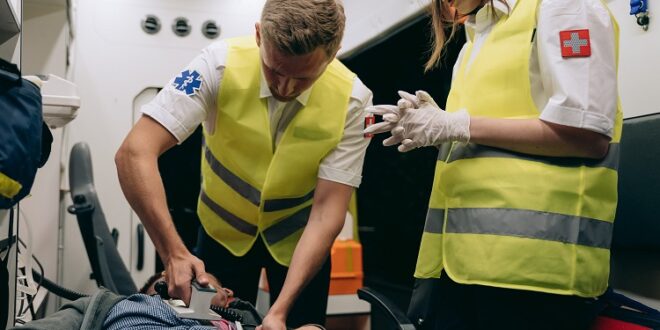In this dynamic day and age, disasters can strike at any moment, demanding immediate attention. We must be prepared with the requisite knowledge and skills to protect ourselves from difficult circumstances. A vital tool that has gained traction in recent years is the Automated External Defibrillator (AED). But who is appropriately trained to use such a device in the wake of an emergency? That is a crucial inquiry worth exploring. Considering how essential it is to acquire proficient know-how in using an AED, it behooves getting trained today.
What is an AED?
An Automatic External Defibrillator (AED) is a life-saving medical device designed to provide emergency treatment for people suffering from sudden cardiac arrests. This automated equipment can quickly analyze a victim’s heart rate and rhythm and, if necessary, deliver an electric shock to restore a normal heartbeat. The device is relatively easy to use, even for those without medical training, making it a vital tool in cases of sudden cardiac arrest. AEDs can be found in public places such as airports, schools, workplaces, ambulances, and first-responder vehicles. This technology has drastically improved the chances of survival for those who suddenly experience cardiac events; consequently, being familiar with the functioning and location of these lifesaving devices is essential for everyone.
AED Training: Not Just for Medical Professionals
- Medical Personnel: Skilled medical personnel, such as physicians, nurses, and paramedics, all receive comprehensive training on the use of automated external defibrillators (AEDs), arming them with the expertise necessary to accurately assess the patient’s condition and adequately deploy an AED to revive the individual. Such well-versed individuals can be trusted to bring a person back from the brink of death effectively.
- First Responders: When every second matters, it is essential to have first responders trained using automated external defibrillators (AEDs). Police officers, firefighters, and emergency medical technicians (EMTs) often arrive before medical professionals and provide immediate assistance. All of these personnel understand the vital importance of having the confidence and capability to perform AED interventions when time is of the essence. AED training empowers these individuals with the knowledge to be well-equipped to respond during a critical moment.
- Lay Rescuers: AED training is no longer limited to those in healthcare or emergency response roles. By reaching out to organizations and community groups, lay rescuers without medical backgrounds can now acquire the skills to respond rapidly to urgent situations. This unprecedented accessibility ensures that everyday citizens can have a direct hand in life-saving emergencies.
- Corporate Employees: In a world where every second counts, corporate organizations have rightly acknowledged the lifesaving value of Automated External Defibrillators (AEDs). To ensure prudent handling of emergencies, employers have implemented rigorous training programs for their staff members, affording them the knowledge and the confidence to respond swiftly and effectively.
- School Staff: Educational institutions recognize the importance of AED training for staff members. Teachers, administrators, and all other personnel should know what is necessary to respond to a medical emergency. Ensuring this level of preparedness bestows peace of mind upon students and faculty, creating a safe environment for everyone at the school.
- Community Centers and Clubs: Community Centers and Clubs play a pivotal role in creating a well-informed society, partnering with AED providers to furnish compelling training sessions and arm members with the knowledge and skills required to address cardiac events adequately. By forging communal connections and sowing the seeds of readiness, these initiatives form an integral layer of protection within our neighborhoods, allowing citizens to combat the perils of cardiac arrest courageously.
- Sports Coaches and Athletes: As sports infrastructure continues to embrace the invaluable life-saving potential of automated external defibrillators (AEDs), coaches and athletes are increasingly undergoing training to hone their skills in administering the device. With cardiac emergencies requiring instant action, this education is essential for preventing fatalities on the field and optimizing outcomes. By equipping players with the knowledge to respond to health crises swiftly, we can ensure maximum safety and optimal performance for all individuals involved in sporting activities.
Key Components of AED Training
- Recognizing a Cardiac Emergency: As a pivotal aspect of AED instruction, detecting the indicators of cardiac arrest is paramount. Imparting the need for swift intervention and summoning professional aid are central tenets of any training program. Underscoring the urgency of such measures is essential for minimizing the associated risks and ensuring optimal outcomes.
- Proper AED Usage: Through this course, participants become versed in the essential protocol for employing an Automated External Defibrillator (AED). Hands-on instruction covers various aspects of the device’s operation, such as where to place the pads, how to initiate it, and how to adhere to the voice prompts offered during its utilization. With a thorough grasp of these fundamentals, individuals are equipped with the knowledge to confidently and accurately utilize an AED.
When considering who is trained to use an AED in case of an emergency, it’s evident that a diverse range of individuals, from medical professionals to lay rescuers, actively contribute to creating safer communities. The inclusivity of AED training programs in workplaces, schools, and community centers underscores the importance of preparedness for unexpected cardiac emergencies. By understanding the significance of swift action and proper AED usage, we collectively enhance the chances of saving lives. Remember, when it comes to AEDs, the LIFEPAK CR2 | AED Advantage stands out as a reliable and essential tool for those trained to make a difference.
 HammBurg Be informed with latest news, reviews, entertainment, lifestyle tips, and much more.
HammBurg Be informed with latest news, reviews, entertainment, lifestyle tips, and much more.




